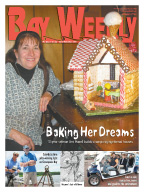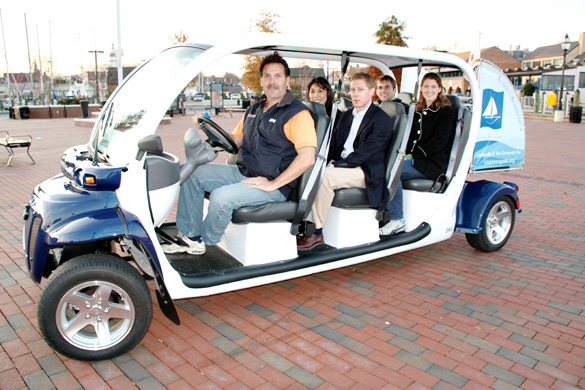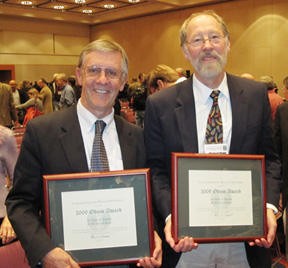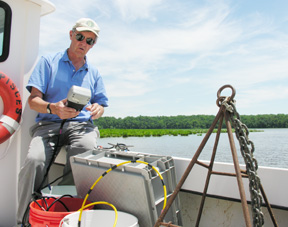Chesapeake Bay's Independent Newspaper ~ Since 1993
1629 Forest Drive, Annapolis, MD 21403 ~ 410-626-9888
Volume XVII, Issue 49 ~ December 3 - December 9, 2009
Home \\ Correspondence \\ from the Editor \\ Submit a Letter \\ Classifieds \\ Contact Us
Dining Guide \\ Home & Garden Guide \\ Archives \\ Distribution Locations \\ Advertising
![]()


|
Catch a Holiday Lift in Historic Annapolis
E-cruisers give an e-xemplary ride
Imagine a ride that was free, smart and good for the environment. Sound like a dream?
No, it’s on the road, carrying passengers around historic Annapolis. And you can’t beat the price.
Catch a ride on weekends and during holiday events — Midnight Madness, the Eastport Yacht Club Parade of Lights and Bring New Year’s into Port.
The little buggies run on 100 percent electricity and recharge at Navy-Marine Corp Memorial Stadium. One four- to six-hour charge gives 25 miles to these small eco-ficient cruisers.
With a fleet of eCruisers offering free rides from historic Annapolis to Eastport, Russell Rankin is the sandman of this dream. He started herding eCruisers in Ocean City.
“I just saw the need for a niche where people simply needed to get from point A to point B,” he said.
Point A was the bay side of the city; point B was the ocean side.
“Everybody just loved the idea of a free ride,” he said. “It took out so many inconveniences from their routine.”
Rankin left his construction job of 30 years to follow his dream. With the help of friends and loans, he introduced the little buggies to Ocean City.
From that start, Rankin came to Annapolis, where his fleet of 10 buggies ply downtown’s streets, supported by local restaurants, hotels and other businesses.
Catching a ride is easy. Flag down the next buggy you see and climb aboard, courtesy of the sponsor. It is, however, customary to tip the unsalaried driver.
One buggy, serving Loews Annapolis Hotel, is restricted to customers.
Of the 10 cruisers, one stands out from the other nine yellow-and-white buggies. The Annapolis & Anne Arundel County Conference & Visitors Bureau has adopted the 10th, branded it Come Sail Away and painted it blue and white.
Flag down blue-and-white Come Sail Away, and along with the cheap ride, you also get a driver who’s a knowledgeable guide full of tips on all there is to do and see in Maryland’s capital city.
Tourists are happy to hear about a free ride that is also earth-friendly. “I already drive a hybrid so I would definitely use transportation that was good for the environment,” said Christine Migton — visiting from Morristown, N.J.
Locals also ride free.
“It sounds fantastic,” said Sarah Fry, who works at Hard Bean Coffee and Book Sellers. “I get tired of taking taxis, so it would really save people a lot of money, especially in this economy.”
Paul Murphy of Annapolis said the eCruisers are a good idea to take cars off the road. “It’s a safe way for bar hoppers to get home.”
Detectives of the Deep
|
This week’s Creature FeatureTurtles Join the Technological AgeLoggerhead turtles are late in joining the WiFi generation, but scientists hope that a technological upgrade will replenish their diminishing numbers.
Researchers with Northeast Fisheries Science Center Laboratory in Woods Hole, Mass., have equipped two loggerhead turtles — listed as threatened under the Endangered Species Act — with satellite-linked data loggers in hopes that studying their movements will help them understand turtle behavior. The scientists aren’t interested in turtle gossip. Rather they hope to track behavior patterns of turtles in commercial fishing areas. This knowledge will in turn help the scientists find ways to keep turtles out of fishing nets. Scientists are also spying on several non-tagged loggerheads with the assistance of ROVs — remotely operated vehicles — that follow the reptiles as they swim. No word yet on what the turtles think of their new robotic companions. –Diana Beechener |
 eCruiser owner Russell Rankin behind the wheel with passengers Sarah Zelonis and Mark Bennett, both of Chicago, and Andrew Washington and Catherine Matthews of Houston.
eCruiser owner Russell Rankin behind the wheel with passengers Sarah Zelonis and Mark Bennett, both of Chicago, and Andrew Washington and Catherine Matthews of Houston.


